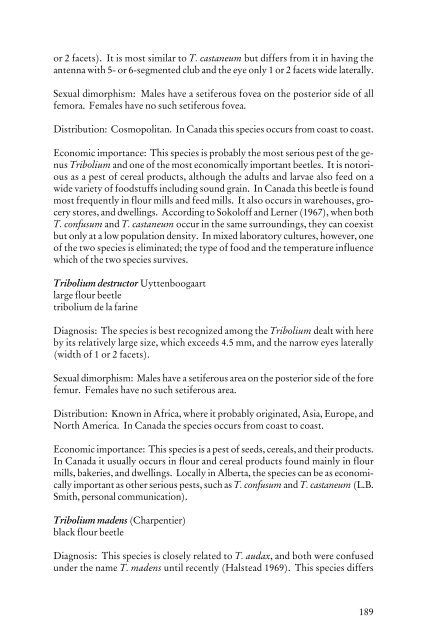Beetles Identification Guide
Beetles Identification Guide
Beetles Identification Guide
You also want an ePaper? Increase the reach of your titles
YUMPU automatically turns print PDFs into web optimized ePapers that Google loves.
or 2 facets). It is most similar to T. castaneum but differs from it in having the<br />
antenna with 5- or 6-segmented club and the eye only 1 or 2 facets wide laterally.<br />
Sexual dimorphism: Males have a setiferous fovea on the posterior side of all<br />
femora. Females have no such setiferous fovea.<br />
Distribution: Cosmopolitan. In Canada this species occurs from coast to coast.<br />
Economic importance: This species is probably the most serious pest of the genus<br />
Tribolium and one of the most economically important beetles. It is notorious<br />
as a pest of cereal products, although the adults and larvae also feed on a<br />
wide variety of foodstuffs including sound grain. In Canada this beetle is found<br />
most frequently in flour mills and feed mills. It also occurs in warehouses, grocery<br />
stores, and dwellings. According to Sokoloff and Lerner (1967), when both<br />
T. confusum and T. castaneum occur in the same surroundings, they can coexist<br />
but only at a low population density. In mixed laboratory cultures, however, one<br />
of the two species is eliminated; the type of food and the temperature influence<br />
which of the two species survives.<br />
Tribolium destructor Uyttenboogaart<br />
large flour beetle<br />
tribolium de la farine<br />
Diagnosis: The species is best recognized among the Tribolium dealt with here<br />
by its relatively large size, which exceeds 4.5 mm, and the narrow eyes laterally<br />
(width of 1 or 2 facets).<br />
Sexual dimorphism: Males have a setiferous area on the posterior side of the fore<br />
femur. Females have no such setiferous area.<br />
Distribution: Known in Africa, where it probably originated, Asia, Europe, and<br />
North America. In Canada the species occurs from coast to coast.<br />
Economic importance: This species is a pest of seeds, cereals, and their products.<br />
In Canada it usually occurs in flour and cereal products found mainly in flour<br />
mills, bakeries, and dwellings. Locally in Alberta, the species can be as economically<br />
important as other serious pests, such as T. confusum and T. castaneum (L.B.<br />
Smith, personal communication).<br />
Tribolium madens (Charpentier)<br />
black flour beetle<br />
Diagnosis: This species is closely related to T. audax, and both were confused<br />
under the name T. madens until recently (Halstead 1969). This species differs<br />
189
















